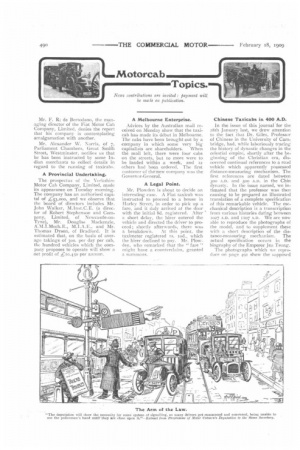Topics.
Page 12

Page 13

If you've noticed an error in this article please click here to report it so we can fix it.
News contributions are invited : payment will be male on publication.
Mr. F. R; de Bertodano, the managing director of the Fiat Motor Cab Company, Limited, denies the report that his company is contemplating amalgamation with another.
Mr. Alexander W. Norris, of 7, Parliament Chambers, Great Smith Street, Westminster, notifies as that he has been instructed by some Indian merchants to collect details in regard to the running of taxicabs.
A Provincial Undertaking.
The prospectus of the Yorkshire Motor Cab Company, Limited, made its appearance on Tuesday morning. The company has an authorised capital of £53,000, and we observe that the board of directors includes Mr. John Walker, M.Inst.C.E. (a director of Robert Stephenson and Company, Limited, of Newcastle-onTyne), Mr. Douglas Mackenzie, A. Mi.. Mech. E. , M. I .A . E., and Mr. Thomas 'Dyson, of Bradford. It is estimated that, on the basis of average takings of 30s. per day per cab, the hundred vehicles which the company proposes to operate will show a net profit of .143,450 per annum. A Melbourne Enterprise.
Advices by the Australian mail received on Monday show that the taxicab has made its debut in Melbourne. The cabs have been brought out by a company in which some very big capitalists are shareholders. When the mail left, there were four cabs on the streets, but to more were to be landed within a .week, and 12 others had been ordered. The first customer of the new company was the Governor-General.
A Legal Point.
Mr. Plowden is about to decide an interesting ease. A Fiat taxicab was instructed to proceed to a house in Ifarley Street, in order to pick up a fare, and it duly arrived at the door with the initial 8d. registered. After a short delay, the hirer entered the vehicle and directed the driver to proceed; shortly afterwards, there was a breakdown. At this point, the taximeter registered Is. tod., which the hirer declined to pay. Mr. Plowden, who remarked that the " fare " might have a counterclaim, granted a summons.
Chinese Taxicabs in 400 A.D.
In the issue of this journal for the 28th January last, we drew attention to the fact that Dr. Giles, Professor of Chinese in the University of Cambridge, had, while laboriously tracing the history of dynastic changes in the celestial empire, shortly after the beginning of the Christian era, discovered continual references to a road .vehicle which apparently possessed distance-measuring mechanism. The first references are dated between 300 A.D. and soo A.D. in the Chin dynasty. In the issue named, we intimated that the professor was then causing to be prepared an illustrated translation of a complete specification of this remarkable vehicle. The mechanical description is a transcription from various histories dating between 1027 A.D. and 1507 A.D. We are now able to reproduce the photographs of the model, and to supplement these with a short description of the distance-measuring mechanism. The actual specification occurs in the biography of the Emperor Jen Tsung.
The photographs which we reproduce on page 491 show the supposed general arrangement of the mechanism. The road wheels were two in number, and were six feet in diameter. According to ancient measurement, a pace was equal to six feet, and, therefore, ope complete revolution of the road wheel covered approximately 18 feet. The measure of distance, which was evidently adopted as standard, and the completion of which was registered by the beating of a drum, had the disconcerting name of Ii, and this was then reckoned as 300 paces of six feet each. The train of gearing consisted of a pin-gear bevel drive from the off-side road wheel ; this had a reduction of iS into 54. Vertical shafts then carried a further toothed-gear reduction of as much as 3 into too. The drum
banged at every fi, and the bell struck at every 10-/i stage, and, interconnecting the bell and drum, trip-gearing arrangement, was a further to-tor tooth gear reduction. The trip-gear is operated quite simply by the revolution of trips fitted to the revolving shafts. The model .has, for convenience, been provided with brass gear wheels, whereas the original was probably made of wood throughout.
























